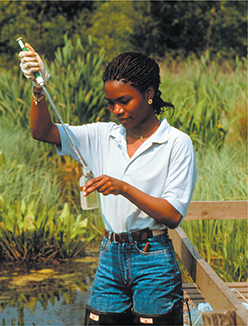In 1997, two meteorologists conducted a controlled experiment to determine if moving faster keeps you drier in the rain. In the experiment, both scientists traveled 100 yards by foot in the rain. One of them walked; the other ran. By measuring the mass of their clothes before and after traveling in the rain, the scientists were able to measure how much water each had accumulated. One of the controlled variables was size—the two scientists were about the same height and build. Another was the rate of rainfall—the scientists began traveling at the same time during the same rainstorm on the same path. A third was the ability to absorb water—the scientists wore identical sets of clothes.
Drawing Conclusions
The scientists' rainy-day experiment produced some convincing data. The clothes of the walking scientist accumulated 217 grams of water, while the clothes of the running scientists accumulated 130 grams of water. Based on their data, the scientists concluded that running in the rain keeps you drier than walking—about 40 percent drier, in fact. Now you have scientific evidence to support the hypothesis stated earlier.
What happens if the data do not support the hypothesis? In such a case, a scientist can revise the hypothesis or propose a new one, based on the data from the experiment. A new experiment must then be designed to test the revised or new hypothesis.
Figure 8 An environmental scientist collects a sample for a water pollution study. After analyzing the sample, the scientist can draw conclusions about how the water became polluted.

Developing a Theory
Once a hypothesis has been supported in repeated experiments, scientists can begin to develop a theory. A scientific theory is a well-tested explanation for a set of observations or experimental results. For example, according to the kinetic theory of matter, all particles of matter are in constant motion. Kinetic theory explains a wide range of observations, such as ice melting or the pressure of a gas.
Theories are never proved. Instead, they become stronger if the facts continue to support them. However, if an existing theory fails to explain new facts and discoveries, the theory may be revised or a new theory may replace it.
Scientific Laws
After repeated observations or experiments, scientists may arrive at a scientific law. A scientific law is a statement that summarizes a pattern found in nature. For example, Newton's law of gravity describes how two objects attract each other by means of a gravitational force. This law has been verified over and over. However, scientists have yet to agree on a theory that explains how gravity works.  A scientific law describes an observed pattern in nature without attempting to explain it. The explanation of such a pattern is provided by a scientific theory.
A scientific law describes an observed pattern in nature without attempting to explain it. The explanation of such a pattern is provided by a scientific theory.





